Wired DCC Decoders
This page describes the decoders I used or have considered using for wire-in installations, including both wired decoders and those equipped for use in a six-pin NEM 651 socket (for which I’d wire in the socket). These are separate from lightboard-replacement decoders or Kato’s special purpose decoders, which have their own pages.
This page is not intended to be a summary of all DCC wire-in decoders, or even those suitable for N-scale trains. The focus here is on the kind of decoders I need, which are primarily separate cab and motor decoders since most of my trains are multiple-unit trains where the motor is located mid-train, separate from the head and tail lights in the cab. Even there, I’m going to focus on a subset of possible decoders. If you want a good summary of what’s available, check out the Motor Decoder and Cab Decoder summaries on Akihabara Station. The pages haven’t been updated in a couple of years, but decoders don’t evolve all that quickly.
Information on this page is current as of November 2012.
Decoder Basics
Decoders have addresses. In a train with two cab cars and a separate motor car, it might seem that you need three addresses. But all you need is to program the cars individually on a programming track to the same address. Once on the operational track, any programming command sent to the train will affect all three decoders, so you need to be careful doing that.
In a train with more than one set of cab and motor cars (e.g., one of my 10+5 sets, that can be separated into two trains) it’s probably best to treat each set as an individual train, and then use consisting to get them to both respond to one “consist address”. That way you can control the two individually, or as a unit. The number of available consist addresses is somewhat limited, so you may not be able to make the assignment permanent unless you only have a small number of trains and don’t take them to other layouts.
Decoders may support RailCom, Transponding, or no form of reporting information back to the command station. See my DCC Telemetry page for more about why you might care.
Typical manufacturers of decoders include Digitrax, Lenz (Lenz USA website), TCS, and a couple of others noted below.
Simple Motor Decoders
For a motor car that doesn’t have any lights, all you need is just the motor output, not any function outputs. If you also wanted to control interior lighting you’d need one function output for that. Most of the time motor decoders will have several function outputs, and you can just ignore them (if there’s a harness, cut the wires short and make sure the ends don’t touch each other or anything metallic). Note that if you want a decoder for a modern locomotive, you’ll need more than two function outputs, since the head and tail light require one each, and ditch lights would require one or two depending on how you use them (many models only have working head and tail lights, and that’s what these decoders are designed for). With LEDs, you could wire ditch lights to the headlight output and get away with two outputs (three LEDs use less than 100mA), if all you want are always-on ditch lights when the locomotive is moving forwards.
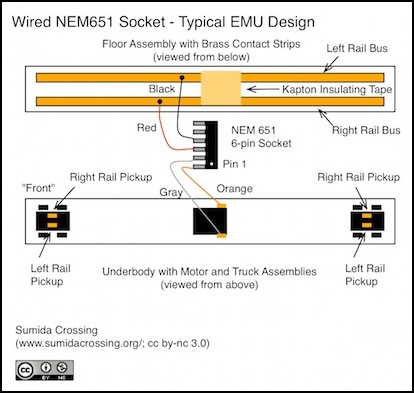
Wiring a NEM 651 Socket into a typical EMU (light function pins unused)
Common Motor Decoders for Small Spaces
All of the decoders listed below support 128 speed steps, “four-digit” addressing and often a host of other capabilities (see the manufacturer’s specs for details). Most also support back-EMF and “supersonic” PWM outputs to the motor (sometimes called “silent operation”), to reduce buzzing that occurred with older decoders. For my use, I want support for both consisting and speed tables, and I’ll note which have it.
Note: motor decoders need to be sized for the “stall current” of the motor. While an N-scale motor draws miniscule power once it’s spinning, when it’s not spinning (at start-up or if something prevents it from turning) it can draw a lot more. Using an undersized decoder is a recipe for a blown decoder. While most modern motors have low stall currents (a Kato DE10 uses less than 250 mA) I’ve seen reports that some older ones use more than 500 mA (Tomix in particular). The Lenz decoder noted below could easily be destroyed by one of these older motors (or perhaps not; some documentation suggests it can support stall currents of 2 Amps; it’s possible that older versions had a lower limit, since fixed).
TCS
A popular motor decoder for N-scale is the TCS M1, which can be had for under US$30. This is a 9.1mm x 14.4mm x 3.4mm decoder, with a 1 Amp motor output and two 100 mA function outputs. It supports “silent” operation (sometimes called “supersonic”) and back-EMF (important for low-speed and constant-speed-on-grade operation). This decoder is sold with a soldered-on wire harness only. However, their EUN651 decoder (also US$30) is nearly identical (the function outputs are rated for 80mA rather than 100mA, but that’s apparently the only difference) and has pins for a six-pin socket, so the two could be used interchangeably for most applications.
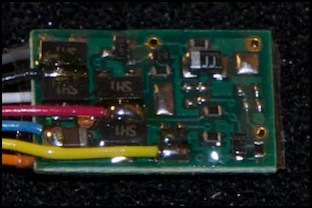
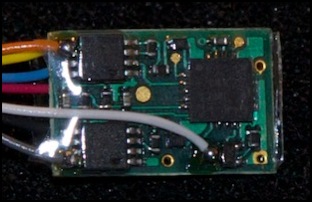
TCS M1
I’ve seen reports of problems on Tomix trains with TCS Back-EMF enabled, and the symptoms sound like an improperly-tuned Back-EMF algorithm. Unfortunately TCS doesn’t allow their algorithm to be tuned (See the DCC Decoders page for more about tuning Back-EMF). To me, this is a significant negative against their motor decoder.
TCS also makes the Z2 (covered in the cab decoder section below). There are reports that the motor outputs on it are more “fragile” than those of the M1.
Digitrax
Another popular decoder is Digitrax’s DZ123 or DZ125. The former is 14mm x 9mm x 3.3 mm, and sells for about US$16. The latter is 10.6mm x 8.6mm x 2.8mm, and and sells for about US$20. Both are 1 Amp decoders, with two 500 mA function outputs. Both are “supersonic” with Transponding and support user-defined speed tables, consisting and “four digit” addresses. The DZ125 works on track voltages up to 20 V, two more than the DZ123. There are some DCC stations putting out that much, or more, but either should work on most systems; you’re buying a bit more safety margin in the more expensive decoder. The real difference between the two is that the DZ123 omits back-EMF, which I consider fairly important and worth the extra cost. The DZ125 is a newer design, and thus slightly smaller, which is also a plus.
The DZ125 can be purchased with pre-soldered wires, or with pins (DZ125IN) to fit an NEM651 socket (the standard NMRA N-scale six-pin socket). It’s also possible to add a supercapacitor to the decoder to let it ride through power problems if you have a good soldering iron and a sure hand, or so says one person who claims to have done this (see this site for info). I’m not sure it’s really necessary for me, but it’s an interesting thought.
Note: The DZ125 may be sensitive to being damaged by some motors. There seem to be a number of problem reports, all of which appear to involve older Tomix trains.
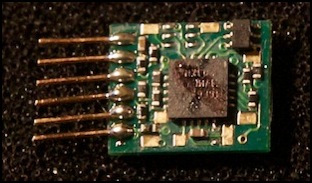
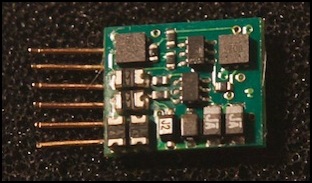
Digitrax DZ125IN (front and back)
Lenz
Another popular decoder is the Lenz Silver Mini+, which goes for around US$43. This is a 11mm x 9mm x 2.8 mm decoder, with a 0.5 Amp motor output (but it can handle up to 0.8 Amp at start-up and possibly >2A stall current, statements in their documentation conflict on this), with two 100mA function outputs. This supports RailCom (see below) as well as back-EMF and supersonic/silent operation, as well as advanced consisting, 128 speed steps, and “four digit” addresses. It also supports a user-defined speed table. This is available in a NEM 651 version as well as a wired version.
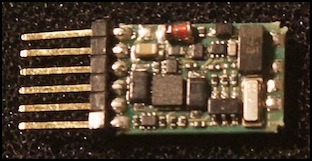
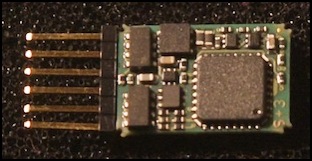
Lenz Silver Mini+ (front and back)
Lenz also makes the Gold Mini+. This is similar, but slightly thicker (at 11mm x 9mm x 3.3 mm), and adds support for “asymmetric DCC” (some proprietary feature of theirs) and an external power module, the POWER-1. This is basically a big capacitor to keep the decoder and motor running if there is a problem due to dirty track or poor pickups on the train. At US$46 it’s an expensive add-on, and rather large to boot at 23mm x 14mm x 9.9mm, which might fit in an N-scale EMU body, but it would be a tight fit. It will provide up to one second of running time for a typical N-scale motor. It could be handy on a model with problematic pickups, or if your layout has serious track problems (but you’d be better off hunting those down and fixing them).
See the Telemetry page for info about their separate RailCom-only decoder.
Railstars
Railstars is new to the decoder scene. I’d previously beta-tested their LOLBooster kit (these are fully assembled). They planned to make three decoders, and I tested the Aegaeon:M, a functionless motor output decoder designed for multiple-unit motor-car use (and the “C”, further down the page). These were to be very small (11mm x 6.7mm), but fairly complete decoders.
As of early 2015, three years after I tested the first version, development of these has been formally put on hold after a long delay. The creator does plan to get back to them someday, but likely not soon.
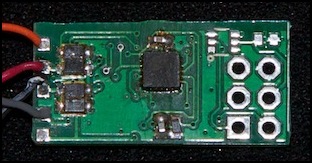
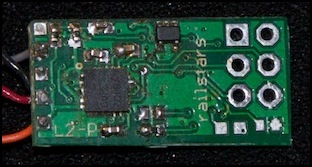
Aegaeon:M
Hard-to-find Decoders
Two other manufacturers recommended on the Akihabara Station links above are the Uhlenbrock 73400 (German website) and CT Elektronik’s DCX75D and DCX74zD (German website). These are hard to find in the U.S., but CT Elektronik has a new model that is incredibly tiny, and may be worth the search.
The current Uhlenbrock seems to be the 73410 (PDF specifications in English), a small (10.8mm x 7.5mm x 2.4mm) decoder with 0.5A motor (1A short-term) outputs two 0.2A function outputs. It’s “supersonic”, but appears to lack back-EMF and speed tables (it does have min/middle/max speed curve CVs). It appears to lack Transponding or RailCom.
CT Elektronik’s DCX76z (German specifications), at 6.9mm x 6.1mm x 1.7mm, is the smallest wired decoder available. For that, it supports 0.8Amp motor output, supersonic operation and back-EMF, speed tables, and the usual features. It appears to lack Transponding or RailCom. Despite the apparent lack of a U.S. distributor, the function outputs specifically support “American” lighting effects per their page.
There’s a company in Japan, NGDCC (Japanese home page), that makes some decoders that can be used as well. I find these a pain to order (there are no resellers), and apparently models go out of production with little notice. Both of the models listed on Akihabara Station for motor-decoder use appear to have been replaced with newer models, but I think there are easier choices for this application, so I’m not going to experiment with them. I have bought some of their “lightboard replacement” decoders for installation in locomotives, although at this time I haven’t installed any yet.
Motor Decoder Summary
In terms of cost, size and features, the DZ125 is a clear leader, if you want Transponding or don’t care. At least of those that I can find anyway; I’d like to try the DCX76z but it appears I’ll have to import them to do that. If you want RailCom, then the Silver Mini+ (or Gold Mini+) is the only choice, but a bit pricy. You could also use some other decoder plus Lenz’s RailCom add-on decoder, but again that’s rather expensive.
Simple Cab-Car Decoders
A Cab-car on a multiple-unit train is a special case. In some, the motor will be in the same car, but in most of the trains I own, the motor is in another car. And thus all you really need is a one or two-function decoder with no motor control. But there’s a “gotcha”: cab cars usually use lightboards to hold the LEDs and lightpipes in place, so you can’t easily wire up function outputs to individual LEDs (and you need to worry about voltage; normally a resistor has to go between the LED or bulb and the output to it, see my page about lightboards).
Lightboards are designed to take the DC from the track, reduce it to the required voltage, and then (using the one-way characteristic of diodes) light either the headlight or taillight depending on the polarity of the voltage on the track (remember “right rail positive” means “go forward” to a properly-wired DC locomotive). So if you could switch the polarity of the function output (called a “bi-polar output”), you could just cut the wires to the lightboard, and wire one function output to the whole board. Life is rarely that simple, as in addition you would need the decoder to switch the polarity of the function based on the directional command being sent to the decoder. So what’s needed in a cab decoder is fairly complex. Or is it?
The TCS FL4 seems to be the most commonly recommended decoder for cab lighting (with good reason), and it and the Lenz LF101XF are recommended by Akihabara Station’s page. However, the LF101XF has been discontinued by the manufacturer and is no longer available.
Using a Motor Decoder
An alternative to this would be to use the motor output on a decoder (which is essentially DC with the polarity controlled by the direction; the fact that’s it’s PWM shouldn’t matter to a LED). The catch here is motor outputs vary their power with the speed of the train. If the decoder supports speed tables, you can use that to force the motor output to always be full voltage. However since it’s not a function output, the only way to turn the headlights off is to have them always be off when the train is stopped, which isn’t prototypical for a train in a station. The “motor output” trick also prevents use of headlight dimming when in a station or passing a train (prototype Japanese trains do this, as well as American ones). One downside here is that motor decoders tend to be more expensive than function-only decoders, due to heavier circuitry.
Simple Cab Car Decoders
The ideal decoder for this purposes is small, and supports both bi-polar outputs and directional control of that. Support for “four digit” addresses and consisting is desirable as well. The following do so unless otherwise noted:
Lenz
The LF101XF had been a candidate, it has been discontinued by Lenz per a distributor. This was a larger (21.6mm x 12.0mm x 3.0 mm) decoder, typically US$22, which had six function outputs rated for 200mA. CV49 controlled polarity-dependent lighting of the first two functions. It used standard color codes although the default mapping didn’t quite line up (function A was white, but defaulted to F1, not F0).
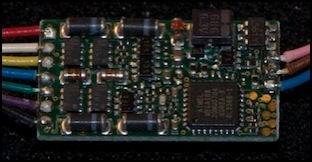
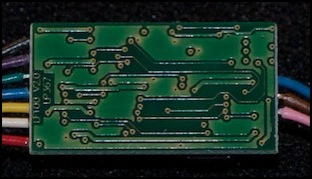
Lenz LF101XF (front and back)
Railstars
Railstars is new to the decoder scene. In fact, these decoders are still beta. I’d previously beta-tested their LOLBooster kit (these are fully assembled). They make three decoders, but I tested the Aegaeon:C, a bipolar output decoder designed for multiple-unit cab use (and the “M”, up above). These are very small (11mm x 6.7mm), but fairly complete decoders.
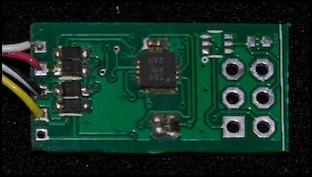
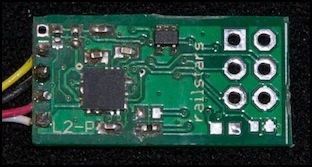
Aegaeon:C (front and back)
TCS
The FL4 is a low-cost (US$18 typical) and small (9.12mm x 14.1mm x 2.92mm) decoder with four function outputs rated for 200mA. To be programmed, the decoder must have at least one function wired with a resistor of 50 ohms or larger (meaning it will work if one LED is wired). CV21 controls directional control of either the green (set to 1) or purple (set to 2) function wires. Reset is to set CV8 to 2. I’d been confused by something I read, and initially cited the FL4 as a good cab decoder for existing lightboards, under the assumption it supported bipolar output. It does not. It’s a good decoder if you can wire directly to the lights, but not if you need one output that changes polarity.
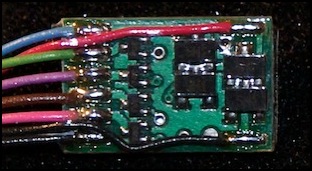
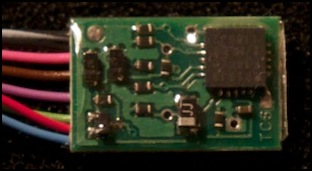
TCS FL4 (front and back)
The Z2 is TCSs smallest motor decoder (US$32 typical), and can be used as a bipolar decoder by using its motor outputs. It also supports two function outputs (limited to 60mA, so these aren’t suitable for bulb lighting). The M1 is essentially identical, and slightly cheaper. It’s also reputed to have a more robust motor output.
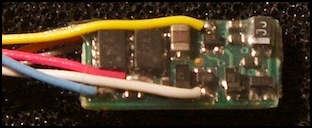
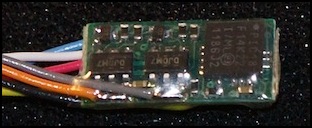
TCS Z2 (front and back)
Other Cab Decoders
Using the motor-outputs it should be possible to control a polarity-sensitive lightboard, with some limitations. To do this requires a speed mapping table (so full voltage can be output to the “motor” at all speeds).
There’s one other possibility: NGDCC (link above) makes a couple of bipolar function decoders, but the current versions bear a notice suggesting that they could be “terminated at any time”, which probably means that they’re out of production. The US$17 price for the 18 mm x 11mm x 2.3 mm DF11r4 is quite attractive, but shipping will add to that. In the end I decided that I didn’t want to deal with the language barrier for something as complicated as a decoder just to save a few bucks.
Digitrax
The DZ123 (14mm x 9mm x 3.3 mm; sells for about US$16) or DZ125 (10.6mm x 8.6mm x 2.8mm; sells for about US$20) could be usable in this manner. I’ve seen some comments that the motor outputs on these are easily blown, although I’m not sure that’s true of current ones (some of the early production was known to have problems).
Cab Car Decoder Summary
The TCS FL4 is the best here for separately-wired head/tail lights. The Lenz LF101XF had been my preferable choice when used with an existing lightboard, but since it’s been discontinued I’ll need to investigate an alternative. The Aegaeon:C looks promising, but it’s still in beta as of winter 2012/2013.




